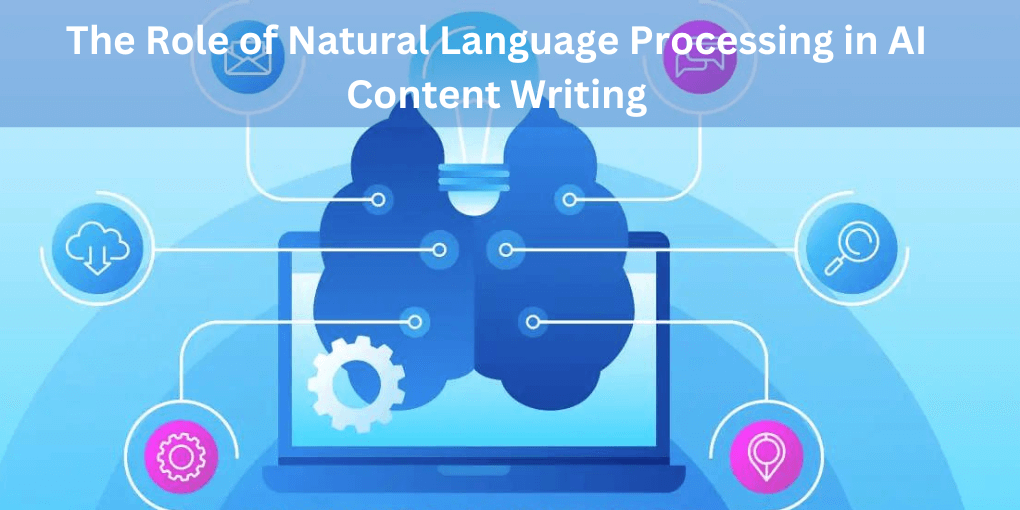Boost your brand’s online presence with a proven content marketing strategy that’s tailored to your unique needs and goals with the help of natural language processing .

Natural Language Processing (NLP) is a field of computer science and artificial intelligence that focuses on the interaction between human language and computers.
The goal of NLP is to enable computers to understand, interpret, and generate human language.
With the exponential growth of digital data and the rise of machine learning algorithms, NLP has become an increasingly important field in recent years.
NLP applications are everywhere, from virtual assistants like Siri and Alexa to automated chatbots and sentiment analysis tools used by businesses to understand customer feedback.
In this post, we will explore the basics of NLP and its various applications in our daily lives.
Benefits of Natural Language Processing in AI Content Creation
Natural Language Processing (NLP) is an exciting field of artificial intelligence (AI) that has revolutionized the way we interact with computers.
In recent years, NLP has become an indispensable tool in content creation, helping content creators to streamline their work and create better-quality content that resonates with their audience.
Here are some of the benefits of using NLP in AI content creation:
Improved Content Quality
NLP tools can analyze text and provide suggestions for improving grammar, punctuation, and spelling errors.
This helps content creators to create high-quality content that is easy to read and understand.
Time and Cost Savings
NLP tools can automate repetitive tasks such as proofreading, grammar checking, and content analysis, freeing up time for content creators to focus on other aspects of content creation.
This can lead to significant time and cost savings for content creation teams.
Audience Targeting
NLP tools can analyze the tone and sentiment of a piece of writing, helping content creators to optimize their content for specific audiences.
This ensures that the content resonates with the intended audience and is more likely to be shared on social media, resulting in increased engagement and traffic.
Content Generation
With advancements in AI technology, NLP can now create coherent sentences and even entire articles with little to no human intervention.
While this technology is still in its early stages, it has the potential to revolutionize the content creation industry.
Competitive Advantage
Using NLP in content creation can provide a competitive advantage by enabling content creators to produce higher-quality content faster and more efficiently than their competitors.
How NPG is Revolutionizing the Content Writing Industry
Natural Language Generation (NLG) is a subset of Natural Language Processing (NLP) that uses AI algorithms to generate written or spoken language.

NLG is revolutionizing the content writing industry by providing a way to automatically produce high-quality, relevant content at scale. Here are some ways that NLG is changing the content writing landscape:
Cost-Effective Content Creation
NLG can create content at a fraction of the cost of human writers. By automating the content creation process, businesses can save time and money while still producing high-quality content that resonates with their audience.
Speed and Efficiency
NLG can generate content quickly and efficiently, allowing businesses to produce more content in less time.
This speed and efficiency enable content writers to focus on other essential tasks, such as strategy and analysis, while the NLG handles the bulk of the writing.
Customizable Content
NLG allows businesses to customize content for different audiences and channels. By using NLG, businesses can generate unique content for different segments of their audience. It ensures each piece of content resonates with its intended audience.
Consistent Quality
NLG produces consistent quality content, regardless of the volume or complexity of the content.
NLG algorithms can check for grammar and spelling errors, ensure that the content is coherent and flows logically, and provide feedback for improvements.
Scalability
NLG can scale to meet the needs of any business, whether they need to create a few pieces of content per week or thousands of pieces per day.
NLG can generate content on demand, providing businesses with the flexibility they need to meet their content creation goals.
Applications of Natural Language Processing in Content Writing
Natural Language Processing (NLP) is a subfield of artificial intelligence (AI) that focuses on the interaction between computers and humans in natural language.
NLP has become an essential tool for content writers looking to create compelling and engaging content for their audiences.
Here are some of the applications of NLP in content writing:
Language Analysis: NLP can analyze text to identify parts of speech, syntax, and semantics, enabling content writers to create content that is grammatically correct and easy to read.
Sentiment Analysis: NLP can analyze the tone and sentiment of a piece of writing, helping content writers to optimize content for specific audiences. This ensures that the content’s tone matches the brand’s voice and values.
Content Generation: NLP can generate natural language content, including headlines, product descriptions, and even entire articles. This feature allows content writers to automate tasks such as product descriptions, freeing up time for other content creation tasks.
Content Optimization: NLP can help content writers to optimize their content for search engines by identifying relevant keywords and analyzing the structure of the content. This optimization ensures that the content is more likely to rank high in search engine results pages.
Personalization: NLP can personalize content for individual users, creating a unique experience for each user. This personalization can improve engagement and increase customer loyalty.
Chatbots: NLP can power chatbots, enabling businesses to provide 24/7 customer support to their customers. Chatbots can respond to customer inquiries, provide product recommendations, and even complete transactions.
Tips for Implementing Natural Language Processing in Content Writing
Natural Language Processing (NLP) is becoming an increasingly popular tool for content writers looking to create engaging and relevant content.

Implementing NLP can be challenging, especially for those who are new to the technology. Here are some tips for implementing NLP in content writing:
Define the goals of the project
Before implementing NLP, it’s essential to define the project’s goals. What problem are you trying to solve with NLP, and how will you measure success?
This will help you to determine the appropriate NLP techniques to use and ensure that your efforts are focused.
Choose the right NLP tools: There are many NLP tools available, and choosing the right one for your project is crucial.
Consider factors such as accuracy, ease of use, and cost when selecting an NLP tool.
Train your NLP model: Training your NLP model is essential to ensure that it can accurately identify and analyze the language in your content.
This involves feeding the model with examples of relevant content and correcting it when it makes mistakes.
Test and refine your NLP model: Testing your NLP model is crucial to ensure that it’s accurate and effective.
Refine your model by reviewing its performance and tweaking the settings as needed.
Use NLP to augment, not replace, human writers: While NLP can automate some aspects of content creation, it’s important to remember that it’s not a replacement for human writers.
Instead, use NLP to augment your team’s efforts by automating tasks such as grammar checking and keyword analysis.
Stay up to date with NLP advancements: NLP technology is rapidly evolving, and staying up to date with the latest advancements can help you to stay ahead of the competition.
Attend industry conferences and workshops, read industry publications, and stay connected with other professionals in the field.
AI Content Writing Using Natural Language Processing
As natural language processing (NLP) technology continues to evolve, AI content writing has become an increasingly popular tool for businesses looking to create engaging and relevant content.
Here are some real-life examples of successful AI content writing using NLP:
Forbes’ AI-Generated Content: Forbes uses an AI-powered tool called Bertie to create draft articles for its contributors. Bertie can analyze the style and tone of an author’s previous work, as well as other data such as keywords and trending topics, to generate a draft article. The contributor then reviews and edits the draft before publishing.
Associated Press Automated News Stories: The Associated Press (AP) uses an AI tool called Wordsmith to create automated news stories based on data such as sports scores and financial reports. Wordsmiths can generate hundreds of articles per day, freeing up AP’s journalists to focus on more in-depth reporting.
Grammarly’s Grammar and Style Suggestions: Grammarly uses NLP to provide grammar and style suggestions to its users. The tool can analyze text and identify issues such as spelling errors, incorrect grammar, and awkward phrasing. This enables writers to create more polished and professional content.
The New York Times’ Automated Headlines: The New York Times uses an AI tool called Editor that can generate automated headlines for articles. Editor can analyze the content of an article and suggest headlines that are optimized for engagement and SEO.
OpenAI’s GPT-3: OpenAI’s GPT-3 is a state-of-the-art language model that can generate natural language content, including articles, summaries, and even poetry. GPT-3 has been used by companies such as Copy.ai to generate ad copy and social media posts.
Limitations of Natural Language Processing in AI Content Writing
While natural language processing (NLP) is a powerful tool for AI content writing, it also has its challenges and limitations. Here are some common challenges and limitations of NLP in AI content writing:
Accuracy: NLP models can be trained to accurately recognize and analyze language, but they are not perfect. The accuracy of an NLP model depends on factors such as the quality and quantity of training data, the complexity of the language, and the model’s algorithm.
Context: NLP models can struggle with understanding the context of language. For example, the word “bank” can refer to a financial institution or a riverbank, and the meaning can only be determined from the context of the sentence.
Creativity: While NLP models can generate text based on existing patterns and data, they cannot create original content or ideas. This makes it difficult for them to create content that is truly unique and engaging.
Bias: NLP models can be biased based on the training data they are fed. For example, if an NLP model is trained on data that is biased against a certain demographic, it may reflect that bias in its language analysis.
Complexity: NLP models can struggle with understanding complex language structures, such as idioms or metaphors. This can make it difficult for them to accurately analyze or generate content that includes such language.
Multilingualism: NLP models can struggle with analyzing or generating content in multiple languages. This is because different languages have different grammatical structures, vocabularies, and syntax.
Data privacy: NLP models rely on large amounts of data to function effectively. However, this data can contain sensitive information, such as personal details or financial data, which raises concerns about data privacy.
Maintenance and updating: NLP models require constant maintenance and updating to ensure that they remain accurate and effective. This can be time-consuming and expensive, particularly for smaller businesses or individuals.
Final Thought
In conclusion, natural language processing (NLP) has the potential to revolutionize the content writing industry.
With the ability to analyze, understand, and generate natural language, NLP-powered AI content writing tools can help businesses create engaging and relevant content more efficiently and effectively.
From automated news stories to grammar and style suggestions, the applications of NLP in content writing are diverse and growing.
However, NLP is not a perfect solution and has its challenges and limitations, such as accuracy, bias, and maintenance.
To make the most of NLP in content writing, businesses and individuals need to understand these limitations and use NLP tools in combination with human writers and editors.

This blog post is written by AI Genie, Powered by ContentGeni’s cutting-edge AI technology. It is able to quickly and efficiently produce high-quality written content on a wide range of topics. While AI Genie may not have a physical body, it is constantly learning and evolving to provide the best possible content for its readers.